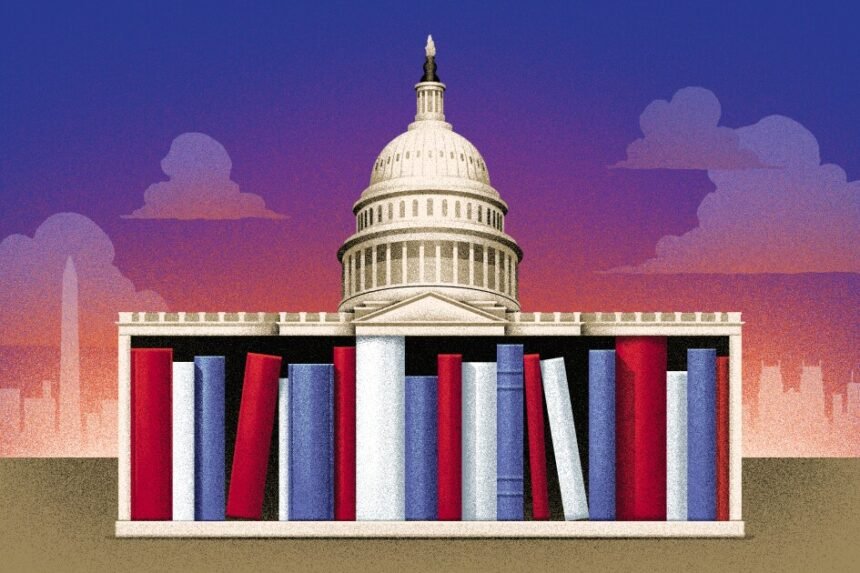Having already cut the U.S. Department of Education’s staff by half earlier this year, the Trump administration announced another round of layoffs citing the government shutdown. Court filings showed an attempt to cut 466 more positions (a bit less than one-fourth of the approximately 2,000 who remain at the department), though the details are all quite hazy. (And hazier still after a U.S. district judge temporarily blocked federal layoffs during the shutdown, only for the White House to announce that 10,000 additional federal workers could be laid off.)
The new cuts have sparked a slew of furious denunciations from progressive groups and the education establishment. They claim that Trump is willing to eviscerate the department out of sheer anti-government fervor. Heck, even the venerable Easterseals, not an especially vocal outfit, issued a PR blast lamenting that the latest cuts have “dismantled key functions that help ensure that students with disabilities receive a quality education.”
Meanwhile, right-coded news and social media discussing the shutdown have mostly featured praise of Trump’s willingness to go after the bureaucracy, demands that Republican lawmakers stand firm, and attacks blaming Democratic senators for causing the shutdown by refusing to support the continuing resolution to fund the government.
Just why it’s tough to have a serious, constructive discussion of these new cuts can teach us a lot about the frustrating nature of education policymaking right now.
First, reaction to the cuts strikes me as mostly a proxy for how one feels about the federal role.
The Republican case for the shutdown layoffs doesn’t entail defending specific cuts. Rather, Education Department spokespeople and senior officials have mostly made vague allusions to “bloat,” “red tape,” and “sending education back to the states,” all rooted in the assumption that federal staff don’t add much value. Indeed, I’d probably argue that the most significant thing the department does is manage the FAFSA, and Linda McMahon’s stripped-down operation managed a seamless, impressive launch this year—after a much larger department spent four years fumbling the congressionally mandated overhaul.
The administration’s critics have responded by predicting massive, horrific consequences. They, too, tend to offer broad allusions, though theirs emphasize the importance of federal leadership, expertise, and oversight, all rooted in the conviction that federal staff play a valuable role. Critics tend to suggest that any significant reduction in headcount will yield troubling results. And they can always, of course, argue that the harm may not yet be visible but will become evident soon enough. They may well be right, but these critiques are mostly going to resonate with those confident that ED staffers are all doing necessary work.
Second, in all of this, I’m struck by the inattention to the particulars of what department staff actually do and the lack of evidence supplied by either camp to support their competing claims. I want to be fair here: I’ve been immersed in federal policy for more than two decades and still have only the haziest understanding of what particular jobs entail. It’s not surprising that most advocates, academics, and policymakers have a very limited sense of what the department actually does or how it does it. But that makes it hard to discuss the concrete (rather than the theoretical) value of given positions or programs. That’s doubly true when the specifics of the layoffs are opaque, as is the case under Trump 2.0.
Third, the shutdown debate is further complicated by the fact that emphatic declarations are now the lingua franca. I’m old enough that I can still remember a time, 10 or 20 years ago, when education coverage had more room for uncertainty or ambiguity. In talking to reporters about No Child Left Behind, teacher evaluation, or the Common Core, they weren’t surprised when I’d describe these as a mixed bag. Today, reporters who don’t know me seem much more inclined to do a double-take when they hear me critiquing both camps. It frequently takes a few follow-ups for them to be confident they’ve heard me right. That means the narratives parents, educators, and policymakers encounter are painted in absolutes.
Fourth, those emphatic declarations have grown more predictable, in no small part, because the penalties for getting out of line have grown steeper for the partisans on either side. During the Biden years, influential Democrats would quietly admit to concerns about student-loan forgiveness but carefully avoid public criticism. If asked why, they’d note this was the price of access and influence. This year, a lot of Republicans have shared similar sentiments. They’ll quietly voice frustrations with what the administration is doing but won’t voice those publicly for fear of being deemed hostile, frozen out, and cut off by Trump-friendly donors. While this dynamic is far from new, it’s grown more severe as we’ve become more polarized. As the penalties for getting out of line have gotten steeper, the willingness to give an inch or to ding your own team has shrunk.
Finally, the triumph of hypocrisy has made it tough for anyone to speak up credibly. It seems to me both that Team Trump is wielding dubious theories of executive discretion pioneered by the Obama and Biden administrations and that it’s supersizing them in new and troubling ways. The issue for Democrats is that their enthusiasm for Obama’s and Biden’s adventurism undercuts those who claim to be appalled by their imitators in the Trump administration—even though they’re right to criticize Trump’s over-the-top, profoundly troubling approach to remaking the bureaucracy. The problem is that since both sides have adopted a habit of trampling laws and norms when they’re in power, only to rediscover these things when opposition is again convenient, the complaints seem unprincipled and unpersuasive.
The resulting debate resembles nothing so much as a Rorschach test. Seen one way, it’s a devastating, unprecedented attack on public support for education. Seen in another, it’s an overdue push to downsize a paper-shuffling bureaucracy that’s allowed federal officials to stymie and bigfoot actual educators. Ideally, the public discourse would pressure-test these competing views. But there’s not much evidence that anyone is even trying to persuade those who think differently; they’re too busy issuing meme-friendly talking points.
If you’re interested in where I come out on these latest cuts, it’s pretty simple: They’re opaque, severe, and lacking in any kind of clear justification. I’m not opposed to them, per se, but I wouldn’t defend them at this point. While I think the concerns are overstated, the hurried and hush-hush nature of the proposed cuts certainly provides fertile ground for skepticism. Ultimately, while I think there’s long been an extraordinary amount of bloat, paper-shuffling, and red tape at the department, it’s hard to deny that sweeping cuts to the Office of Special Education or the Office for Civil Rights will inevitably have real consequences for the department’s ability to answer questions, investigate illegal conduct, or conduct appropriate oversight. As I wrote earlier this year, I’d have much more confidence in proposed cuts if the administration was doing more to explain its strategy and demonstrate its coherence.
Absent that, though, we’re left with a Rorschach test. After all, the logic of the downsizers is that the department is just an unnecessary bit of bureaucracy. And the current logic of those criticizing the cuts is that every federal position and program is essential—and presumably everything would be better if we increased the headcount by 100% … or 1,000%. In this back-and-forth, the department is mostly treated as a powerful symbol rather than a nuts-and-bolts organization—and this is why so much of the debate about its future feels so stylized.
A more constructive conversation demands that we get more precise, principled, and interested in persuasion. That would require that we start with queries rather than declarations, such as: How important is this program? Exactly what are the tasks that make it so important? How many people are actually needed to perform those tasks? What exactly do they do all day? Could those tasks be accomplished more efficaciously? What’s the evidence that these positions or programs deliver the intended results?
I suspect that if we spent less time trading tired talking points, and more discussing these questions, we might find that we’re not actually as far apart as the vitriolic press releases seem to suggest.







